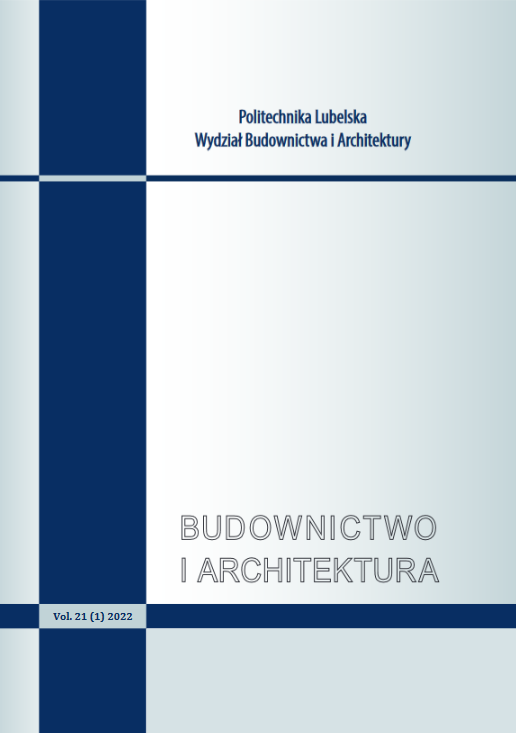Numer 21/1 (2022)
|
Spis treści
Strony
Pobierz
|
|||||
|
Michał Witkowski
Machine Learning (ML) Methods in Assessing the Intensity of Damage Caused by High-Energy Mining Tremors in Traditional Development of LGOM Mining Area
DOI: https://doi.org/10.35784/bud-arch.2679
5 – 17
|
|||||
|
Słowa kluczowe mining damage |housing construction |compensation |damage risk |machine learningStreszczenie The paper presents a comparative analysis of Machine Learning (ML) research methods allowing to assess the risk of mining damage occurring in traditional masonry buildings located in the mining area of Legnica-Głogów Copper District (LGOM) as a result of intense mining tremors. The database of reports on damage that occurred after the tremors of 20 February 2002, 16 May 2004 and 21 May 2006 formed the basis for the analysis. Based on these data, classification models were created using the Probabilistic Neural Network (PNN) and the Support Vector Machine (SVM) method. The results of previous research studies allowed to include structural and geometric features of buildings,as well as protective measures against mining tremors in the model. The probabilistic notation of the model makes it possible to effectively assess the probability of damage in the analysis of large groups of building structures located in the area of paraseismic impacts. The results of the conducted analyses confirm the thesis that the proposed methodology may allow to estimate, with the appropriate probability, the financial outlays that the mining plant should secure for the repair of the expected damage to the traditional development of the LGOM mining area. |
|||||
|
Dmitry Rudchenko,
Vasyl Serdyuk Environmental aspects of the production and use of autoclaved aerated concrete with low density
DOI: https://doi.org/10.35784/bud-arch.2721
19 – 30
|
|||||
|
Słowa kluczowe greenhouse gases |energy saving |construction |autoclaved aerated concrete |low densityStreszczenie The purpose of the article is to investigate the state of carbon dioxide emissions generated as a result of wall materials production and the construction industry as a whole. The paper provides a comparative analysis of housing construction in Ukraine and in some CIS countries. Against the background of the indicators of low housing availability and low relative volumes of housing construction, the issue of high energy consumption remains valid. The absolute and relative volumes of greenhouse gas emissions from economic activity of the population of Ukraine are given. The projected consequences for Ukraine from continued CO2 emissions on the same level and temperature rise are estimated. It is deemed that the most suitable wall material for countries with emerging economies is autoclaved aerated concrete (AAC); since it is a structural and thermal insulating material, it can solve the problem of housing construction. The paper shows the key priority of low energy consumption and makes emphasis on lowering the density of the produced aerated concrete, reducing mineral additives and cement production expenses. INFORMACJE O AUTORACH Vasyl Serdyuk Winnicki Narodowy Uniwersytet Techniczny, Ukraina |
|||||
|
Alaattin Kanoglu,
Deniz Yazicioglu, Ozlem Ozcevik, Nisa Erkovan, Hidayet Softaoglu, Burcu Ulker, Nazli Varlier, Ediz Yazicioglu SIMURG: A new model for the integrated assessment of sustainability
DOI: https://doi.org/10.35784/bud-arch.2902
31 – 57
|
|||||
|
Słowa kluczowe Sustainability Assessment |3D Cartesian System |Philosophical Model |Frame Model |Organizational Model |Computational ModelStreszczenie Sustainability assessment is one of the basic issues in the agenda of public authorities and it requires practical tools to measure performance in terms of sustainable development goals. Most studies in literature deal with only one dimension of the problem of environmental components of sustainability. These studies discuss entities at only one level (cities, buildings, etc.), and one layer (green, smart, etc.) in selected dimensions. The literature includes no models that claim to provide an integrated assessment of entities’ performance in the 3D Cartesian system. The presently available models do not offer solutions that would be applicable in practice. SIMURG (A performance-based and Sustainability-Oriented Integration Model Using Relational database architecture to increase Global competitiveness of construction industry) proposes using layers and their KPI sets in the assessment process. In addition to philosophical, organisational, integrational, and computational models, this study aims to develop a lean architecture of a relational database model by eliminating ineffective solutions in the practical dimension, i.e. in the computer model. The model can be used by individuals to help them choose built environment whose characteristics match their expectations. Public authorities can utilise the model to increase the level of accountability, transparency, and legitimacy in their decision-making processes. INFORMACJE O AUTORACH Alaattin Kanoglu Alanya Alaaddin Keykubat Üniversitesi Kestel Yerleşkesi, Turcja Deniz Yazicioglu Alanya Alaaddin Keykubat Üniversitesi Kestel Yerleşkesi, Turcja Ozlem Ozcevik Uniwersytet Techniczny w Stambule (İstanbul Teknik Üniversitesi), Turcja Nisa Erkovan Alanya Alaaddin Keykubat Üniversitesi Kestel Yerleşkesi, Turcja Hidayet Softaoglu Alanya Alaaddin Keykubat Üniversitesi Kestel Yerleşkesi, Turcja Nazli Varlier Uniwersytet Techniczny w Stambule (İstanbul Teknik Üniversitesi), Turcja Ediz Yazicioglu Uniwersytet Techniczny w Stambule (İstanbul Teknik Üniversitesi), Turcja |
|||||

